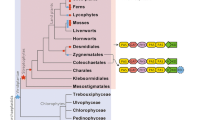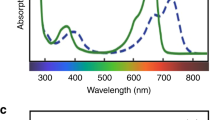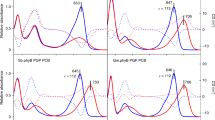Abstract
The molecular cloning of phytochrome (phy) genes has unveiled a rich source of information on the structure, evolution and biological functions of the photoreceptor. In addition, it has provided a powerful experimental system for exploring the central unresolved question in phytochrome research, namely, the molecular mechanism by which the photoreceptor regulates gene expression and thereby plant growth and development.
Access this chapter
Tax calculation will be finalised at checkout
Purchases are for personal use only
Preview
Unable to display preview. Download preview PDF.
Similar content being viewed by others
Further reading
Furuya M. ed. (1987) Phytochrome and Photoregulation in Plants. Academic Press, New York, Tokyo.
Kendrick R.E. and Nagatani A. (1991) Phytochrome mutants. Plant J. 1:133–139.
Quail P.H. (1991) Phytochrome: A light-activated molecular switch that regulates plant gene expression. Annu. Rev. Genet. 25: 389–409.
Quail P.H., Hershey H.P., Idler K.B., Sharrock R.A., Christensen A.H., Parks B.M., Somers D., Tepperman J., Bruce W.B. and Dehesh K. (1991)phy-gene structure, evolution, and expression. In: Phytochrome Properties and Biological Action, pp. 13–38, Thomas B. and Johnson C. (eds.) Springer-Verlag, Berlin.
Rüdiger W. and Thümmler F. (1991) Phytochrome, the visual pigment of plants. Angew. Chem. Int. Ed. Engl. 30:1216–1228.
Thomas B. and Johnson C. eds. (1991) Phytochrome Properties and Biological Action, Springer-Verlag, Berlin.
References
Boylan M.T. and P.H. Quail. (1991) Phytochrome A overexpression inhibits hypocotyl elongation in transgenic Arabidopsis. Proc. Natl Acad. Sci. USA 88:10806–10810.
Bruce W.B., Deng X.-W. and Quail P.H. (1991) A negatively acting DNA sequence element mediates phytochrome-directed repression of phyA gene transcription. EMBOJ. 10: 3015–3024.
Chang C, Bowman J.L., DeJohn A.W. and Lander E.S. (1988) Restriction fragment length polymorphism linkage map for Arabidopsis thaliana. Proc. Natl. Acad Sci. USA 85: 6856–6860.
Chory J. (1991) Light signals in leaf and chloroplast development: photoreceptors and downstream responses in search of a transduction pathway. New Biologist 3: 538–548.
Cotton J.L.S., Ross C.W., Byrne D.H. and Colbert J.T. (1990) Down-regulation of phytochrome mRNA abundance by red light and benzyladenine in etiolated cucumber cotyledons. Plant Mol. Biol. 14: 707–714.
Dehesh K., Bruce W.B. and Quail P.H. (1990) A trans-acting factor that binds to a GT-motif in a phytochrome gene promoter. Science 250:1397–1399.
Dehesh K., Tepperman J., Christensen A.H. and Quail P.H. (1991) phyB is evolutionarily conserved and constitutively expressed in rice-seedling shoots. Mol. Gen. Genetics 225: 305–313.
Dehesh K., Hung H., Tepperman J.M. and Quail P.H. (1992) GT-2: A transcription factor with twin autonomous DNA-binding domains of closely related but different target sequence specificity. EMBOJ. 11: 4131–4144.
Furuya M. (1989) Molecular properties and biogenesis of phytochrome I and II. Adv. Biophys. 25: 133–167.
Gilmartin P.M., Sarokin L., Memelink J. and Chua N.-H. (1990) Molecular light switches for plant genes. Plant Cell 2: 369–378.
Hanelt S., Braun B., Marx S. and Schneider-Poetsch H. (1992) Phytochrome evolution: a phylogenetic tree with the first complete sequence of phytochrome A of a cryptogamic plant (Selaginella martensii Spring). Photochem. Photobiol. 56: 751–758.
Herbomel P. (1990) Synergistic activation of eukaryotic transcription: the multiacceptor target hypothesis. New Biologist 2:1063–1070.
Heyer A. and Gatz C. (1992) Isolation and characterization of a cDNA-clone encoding for potato type B phytochrome. Plant Mol. Biol. 20: 589–600.
Komeda Y., Yamashita H., Sato N., Tsukaya H. and Naito S. (1991) Regulated expression of a gene-fusion product derived from the gene for phytochrome I from Pisum sativum and the uidA gene from E. coli in transgenic Petunia hybrida. Plant Cell Physiol. 32: 737–743.
Lopez-Juez E., Nagatani A., Tomizawa K.-I, Deak M., Kern R., Kendrick R.E. and Furuya M. (1992) The cucumber long hypocotyl mutant lacks a light-stable phyB-like phytochrome. Plant Cell 4: 241–251.
Lissemore J.L. and Quail P.H. (1988) Rapid transcriptional regulation by phytochrome of the genes for phytochrome and chlorophyll a/b-binding protein in Avena sativa. Mol. Cell. Biol. 8: 4840–4850.
McCormac A.C., Wagner D., Boylan M.T., Quail P.H., Smith H. and Whitelam G.C. (1993) Photoresponses of transgenic Arabidopsis seedlings expressing introduced phytochrome B-encoding cDNAs: Evidence that phytochrome A and phytochrome B have distinct photoregulatory functions. Plant J., in press.
Parks B.M. and Quail P.H. (1991) Phytochrome-deficient hy1 and hy2 long hypocotyl mutants of Arabidopsis are defective in phytochrome chromophore biosynthesis. Plant Cell 3:1177–1186.
Parks B.M. and Quail P.H. (1993) hy8, a new class of Arabidopsis long hypocotyl mutants deficient in functional phytochrome A. Plant Cell 5: 39–48.
Reed J.W., Nagpal P., Poole D.S., Furuya M. and Chory J. (1993) Mutations in the gene for the red/far-red light receptor phytochrome B alter cell elongation and physiological responses throughout Arabidopsis development. Plant Cell 5: in press.
Sato N. (1988) Nucleotide sequence and expression of the phytochrome gene in Pisum sativum: Differential regulation by light of multiple transcripts. Plant Mol. Biol. 11: 697–710.
Schneider-Poetsch H.A.W., Sensen C. and Hanelt S. (1991) Are bacterial sensory systems models for phytochrome action? Hydrophobie cluster analysis of the phytochrome module related to bacterial transmitter modules. Z. Naturforsch. 46c: 750–758.
Sharrock R.A. and Quail P.H. (1989) Novel phytochrome sequences in Arabidopsis thaliana: Structure, evolution, and differential expression of a plant regulatory photoreceptor family. Genes Develop. 3:1745–1757.
Smith H. and Whitelam G.C. (1990) Phytochrome, a family of photoreceptors with multiple physiological roles. Plant Cell Environ. 13: 695–707.
Somers D.E., Sharrock R.A., Tepperman J.M. and Quail P.H. (1991) The hy3 long hypocotyl mutant of Arabidopsis is deficient in phytochrome B. Plant Cell 3:1263–1274.
Thümmler F., Dufner M., Kreisl P. and Dittrich P. (1992) Molecular cloning of a novel phytochrome gene of the moss Ceratodon purpureus which encodes a putative light-regulated protein kinase. Plant Mol. Biol. 20:1003–1017.
Tomizawa K.-I, Sato N., Furuya M. (1989) Phytochrome control of multiple transcripts of the phytochrome gene in Pisum sativum. Plant Mol. Biol. 12: 295–299.
Wagner D., Tepperman J.M. and Quail P.H. (1991) Overexpression of phytochrome B induces a short hypocotyl phenotype in transgenic Arabidopsis. Plant Cell 3:1275–1288.
Whitelam G.C., McCormac A.C., Boylan M.T. and Quail P.H. (1992) Photoresponses of Arabidopsis seedlings expressing an introduced oat phyA cDNA: persistence of etiolated plant type responses in light-grown plants. Photochem. Photobiol. 56: 617–622.
Winands A., Wagner G., Marx S. and Schneider-Poetsch H.A.W. (1992) Partial nucleotide sequence of phytochrome from the zygnematophycean green alga Mougeotia. Photochem. Photobiol. 56: 765–770.
Author information
Authors and Affiliations
Editor information
Editors and Affiliations
Rights and permissions
Copyright information
© 1994 Springer Science+Business Media Dordrecht
About this chapter
Cite this chapter
Quail, P.H. (1994). Phytochrome genes and their expression. In: Kendrick, R.E., Kronenberg, G.H.M. (eds) Photomorphogenesis in Plants. Springer, Dordrecht. https://doi.org/10.1007/978-94-011-1884-2_5
Download citation
DOI: https://doi.org/10.1007/978-94-011-1884-2_5
Publisher Name: Springer, Dordrecht
Print ISBN: 978-0-7923-2551-2
Online ISBN: 978-94-011-1884-2
eBook Packages: Springer Book Archive




